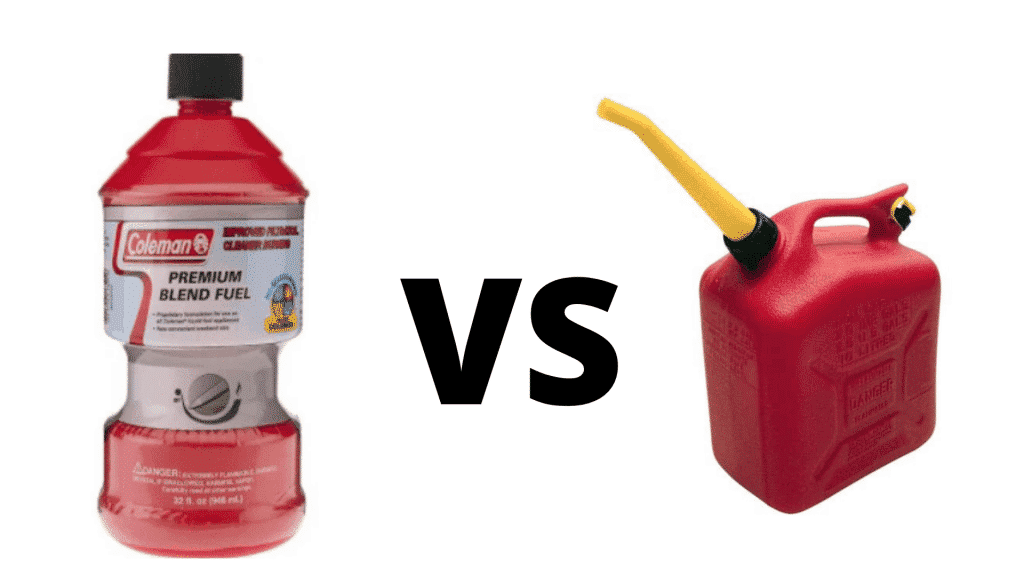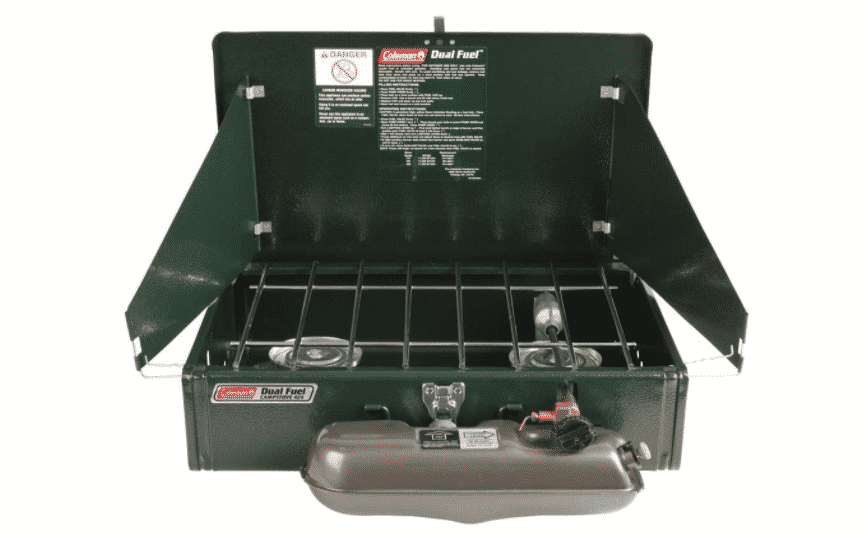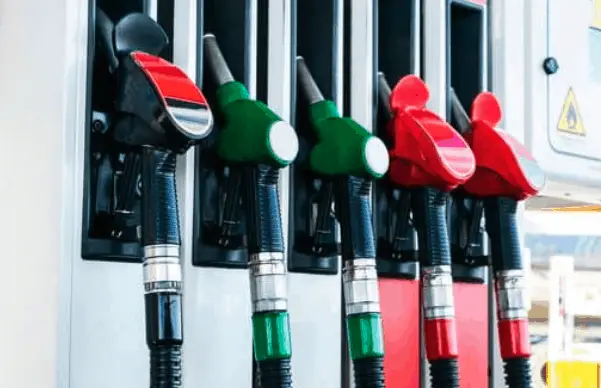Have you ever used a Coleman Stove? I’m willing to bet that you were hit by sticker shock the first time you went to purchase Coleman Fuel. It costs way more than gasoline at about 12$ per gallon at my local Walmart. After reluctantly purchasing a bottle of Coleman fuel I started to wonder if regular gasoline could be used in my Coleman Stove.
Can I use unleaded gasoline in my Coleman Stove? Use gasoline in your Coleman Stove as a last resort. It works well in the short term, but it may cause corrosion and clog fuel lines. You can save some money by going with generic white gas which is slightly cheaper than Coleman Fuel and basically the same thing.
Although gasoline can be used in a Coleman stove it’s not a good idea. Gas can be used in a pinch, but it will eventually damage the liquid fuel reservoir and clog fuel lines.
The rest of this article explains the difference between Coleman Fuel and gasoline and gives a few recommendations on alternative fuels. You might also want to check out this article that lists 5 alternatives to Coleman fuel.
What is The Difference Between Coleman Fuel and Unleaded Gas? (Coleman Fuel vs Gasoline)

On paper Coleman fuel and gasoline seem like very similar products. White gas has flammability similar to gas without all the additives. Most burners and camping stoves will burn both white gas and unleaded gasoline.
You wouldn’t even be able to tell the difference between the two initially. Problems only start to come to light after long term use. Gas will eventually start to clog fuel lines and eat away at the inside of your stove.
Gasoline has lots of additives which are great for your cars engine, but terrible for a Coleman Stove. Your stove doesn’t get hot enough to burn off the additives, so they eventually build-up and clog your fuel lines.
These are the main differences between gas and coleman fuel.
- Cleanliness: Gasoline is relatively clean in a car, but your camping stove won’t be able to burn off all the additives. This will lead to clogged fuel lines as those additives build up.
- Odor: Unlike gasoline, white gas is generally odorless. This isn’t all that big of a deal, but it can affect the taste of your food.
- Price: Gasoline is way cheaper than both Coleman fuel and generic white gas. Think about how much fuel you usually use on a camping trip and figure out the savings. At most you’ll be saving $5 over a weekend camping trip. Is your time spent cleaning the stove worth more than $5? I know mine is!
- Corrosion: Corrosion won’t cause a problem if you use gas every once in a while. This only starts to cause problems with regular use. Eventually, the inside of your fuel reservoir will start pitting.
- Reliability: You will have way less consistency with gasoline. It’s really hard to judge when you need to clean the fuel lines. The stove can light easily in the morning and crap the bed after the temperature drops.
- Stability: White gas and Coleman fuel are far more stable than gasoline. Generally speaking, white gas has a shelf life of around 5-10 years. Gas, on the other hand, goes bad in 3-5 months.
Gasoline Formulas Regularly Change (Unlike White Gas)
Gasoline formulas change depending on where you live and the time of year. They have a summer and winter blend fuel, so there’s no consistency across the country. All the random additives and fuel stabilizers muddy the water further.
They adjust the Reid Vapor Pressure(RVP) to accommodate the different evaporation rates in colder wither. This makes summer blend gas more efficient than winter.
Ethanol Based Fuel is Bad For Coleman Stoves
Gasoline stations in the United States sell three main grades of gasoline based on their octane level. Regular gas is generally 87, Midgrade is 89 and Premium is 91-94.
Wouldn’t it be better to use Premium gas in your camping stove? It’s actually worse, because premium gas usually contains additional additives. These are great for your cars engine, but terrible for your stove.
Ethanol-based gas opens up a whole other can of worms. Most fuel lines are made out of plastic and rubber which melts when it’s exposed to ethanol. These fuel lines can be converted to work with alcohol/ethanol by replacing them with HDPE and PET plastic fuel lines.
Using Gasoline in a Coleman Stove

Personally, I would only use gasoline in an emergency. Coleman fuel is a little more expensive, but a gallon goes a long way.
Use regular gasoline at your own risk and take special precautions. It would suck to head out on your family camping trip and find out that your stove won’t work.
I would highly recommend cleaning out the fuel lines before any long camping trip. On a weekend trip you can probably get by without a stove, but longer than that would be terrible. You can only cook so much food over the campfire.
Cleaning Your Stoves Fuel Lines and Reservoir
Empty out the stove and dispose of the remaining fuel. I just pour it in my lawn mower even though it’s not recommended. This may give your lawnmower headaches, but it’s never been a problem for me.
Don’t Lite The Stove!
Pour in 1/4 tank of alchohol based fuel line cleaner(i like HEET Brand) and swirl it around the tank. Let the solution sit for 20-30 minutes and then empty the cleaner. You should see a bunch of solid pieces of gunk that previously clogged your fuel line.
Add some more fuel line cleaner, open up the stoves valves. Try to get the cleaner to run through all the nooks and crannies. Pour out the remaining mixture.
Make a 20% blend of carb/parts cleaner and 80% white gas and put it in the tank. You don’t need to go over a quarter tank. Light up your burners and run this mixture through your stove until it burns out. At this point your stove is clean so you can fill it up with regular old fuel.
What Can I Use Instead of Coleman Fuel?
There are lots of fuels that you can use instead of Coleman Fuel, but they all have downsides. Most of the other options will eventually clog up your stove or they’re prohibitively expensive.
The following fuels are rated from best to worst based on a variety of factors. I took cost into consideration but also focused on long-term reliability, maintenance, availability, and ease of use.
- Best- Generic White Gas(aka Naptha): Generic white gas is by far the best option for your Coleman stove. It’s $3-$4 cheaper and basically the same thing as Coleman fuel without the proprietary fuel additives and stabilizers. You won’t have to constantly clean the stove and it’s really easy to light.
- 2nd- Gasoline: Gasoline can be used in a pinch, but it will eventually clog your lines and damage your Coleman Stove. I have used it in my stove on multiple occasions after forgetting my jug of fuel. There’s just no reason to drive around searching for Coleman Fuel when gasoline will work. I always drain the fuel reservoir and clean the stove after getting back home.
- 3rd- Kerosine: Whether or not you can actually use kerosene depends on the model of your stove. Some of Coleman’s older stoves would run on kerosene, but it’s not recommended in their current line. It’s just a pain in the butt to use since you need to heat up the preheater tube with an external propane torch and it really doesn’t work well. You can convert any stove to run on kerosene, but that takes a serious DIY approach.
- 4th- Diesel: Diesel is another one of those fuels that can sometimes work, but I wouldn’t recommend it. It’s way dirtier than kerosine but it will leave soot everywhere. It’s easy to find, but unfortunately, it’s hard to light. You will once again need to heat up the preheater tube with a propane torch to get it to light. Don’t even consider using diesel in cold weather.
- Bonus- Other Fuels: It would be impossible to name all the other fuels that can be used in a Coleman Stove. If the fuel lights and it’s non-toxic it can probably be used in a Coleman Stove. Whether or not using biodiesel, paint thinner, racing fuel, etc are cost-effective is another question, but they can get you by in a jam.



